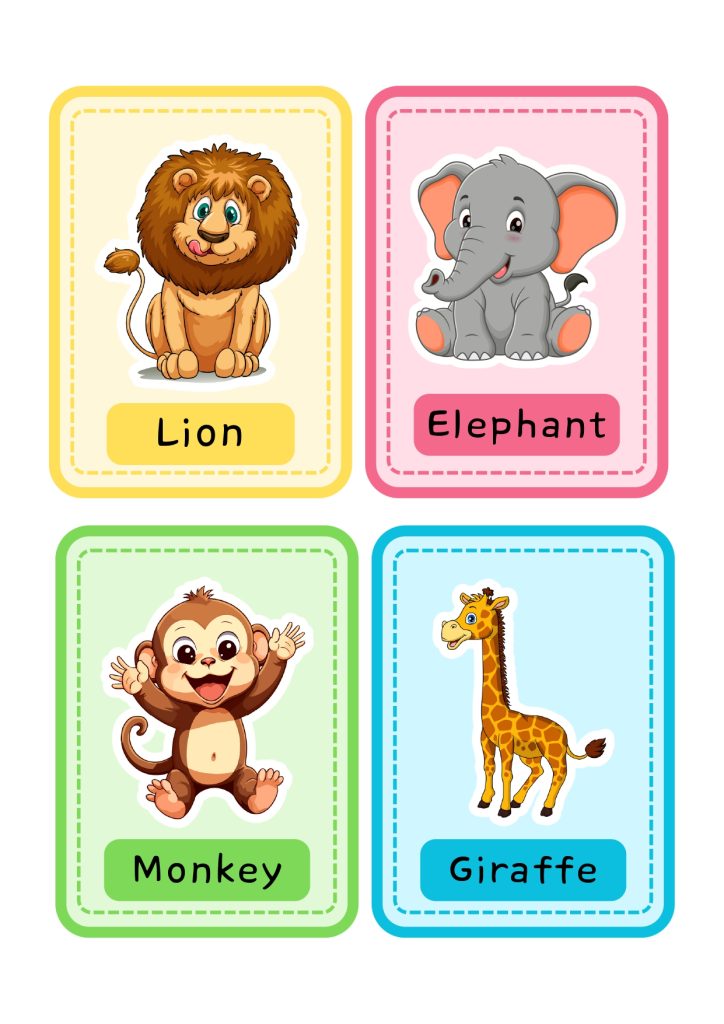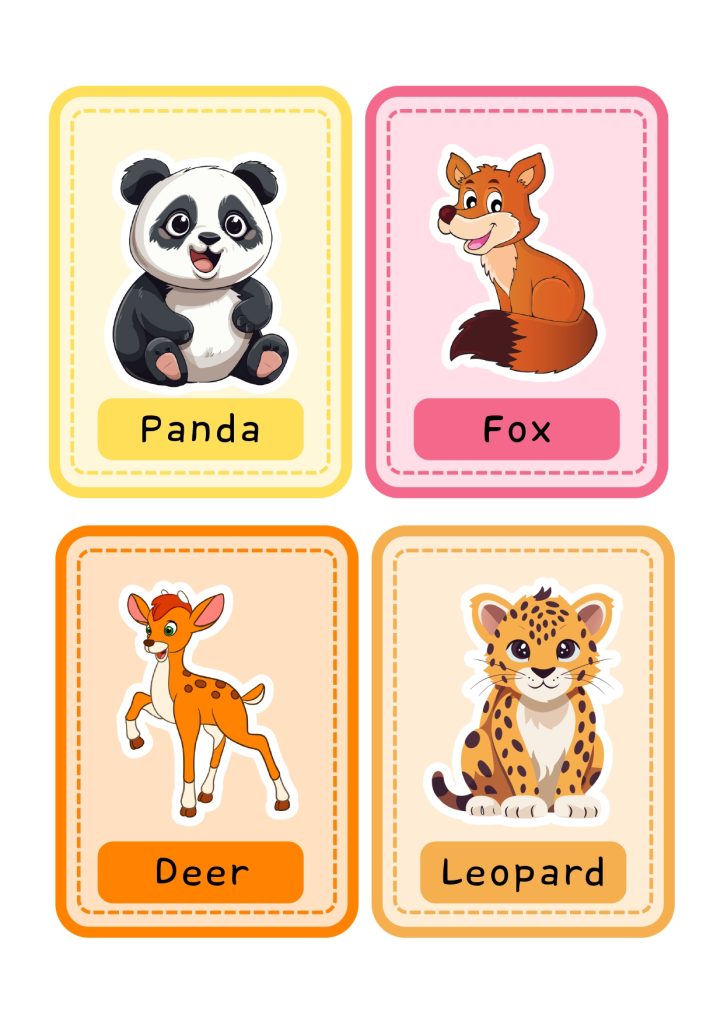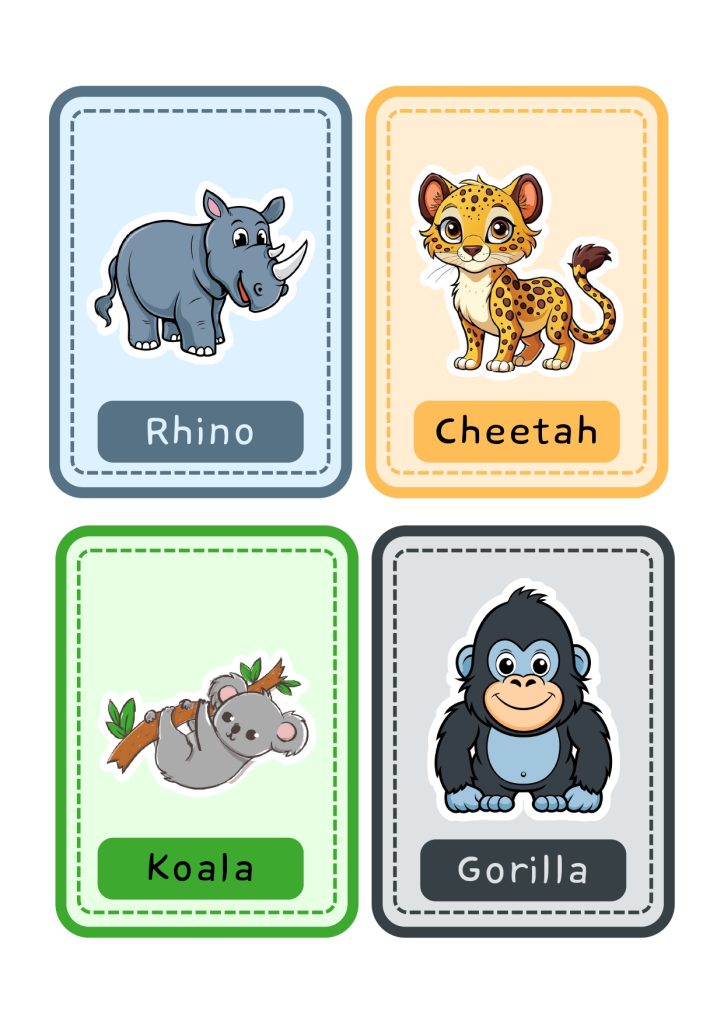Your four-year-old runs to the TV every time a nature documentary comes on. Tigers make them gasp. Elephants make them point and shout. Monkeys make them giggle and try to copy their movements. Kids are hardwired to love wild animals. They’re exciting, and totally different from the pets they know.
These Wild Animals Flashcards work with that natural fascination. Twenty cards showing animals that kids actually see in books, movies, and zoo trips. No weird cartoon versions or confusing artwork. Just clear pictures of real animals that spark curiosity about the world beyond their backyard.
Most kids can spot a dog from across the street. But show them a cheetah with its spotted coat or a gorilla with its massive chest, and suddenly they’re asking a million questions. Where do they live? What do they eat? Are they friendly? Wild animals turn kids into little scientists who want to understand everything.
These cards don’t just teach animal names. They open up conversations about habitats, survival, and how different creatures have adapted to live in places most of us will never visit. When your child learns about penguins, they’re discovering that some birds swim better than they fly. When they see a giraffe, they’re figuring out that being tall helps you reach food other animals can’t get.
Images





Download It Here!
Twenty Animals Worth Knowing
These twenty animals appear everywhere in children’s lives and each teaches something unique about survival in the wild.
- Lion – The animal king with an impressive mane (males only). Females do most hunting, showing kids that male and female animals can look and act very differently.
- Elephant – Amazing trunk works as hand, snorkel, and shower combined. Kids love mimicking elephant movements during play.
- Monkey – Like little people, they swing using tails as extra arms. Makes children wish they had tails too.
- Giraffe – Wins every height contest. Their long necks need special blood vessels to pump blood to the brain, reaching leaves other animals can’t.
- Tiger – Bold orange and black stripes unique to each tiger, like human fingerprints. Surprisingly excellent swimmers despite being cats.
- Bear – Bedtime story favorites that are actually incredible diggers, swimmers, and climbers. Faster than humans with an amazing sense of smell.
- Kangaroo – Carries babies in pouches. Newborns are lima bean-sized and grow in mom’s pouch for months.
- Zebra – Horse-like with unique stripe patterns. When grouped together, stripes create optical illusions confusing predators.
- Panda – Cute but powerful, spending entire days eating bamboo. Need 40 pounds daily because bamboo lacks nutrition.
- Fox – Fairy tale clever character based on reality. Can hear mice under snow and pounce with perfect accuracy.
- Deer – Run 30 mph and jump 8 feet high. Males grow antlers that fall off and regrow annually.
- Leopard – Ultimate tree climbers, stronger than monkeys. Can drag prey twice their weight up branches.
- Rhinoceros – Living tanks weighing like small cars but running 35 mph – faster than most cyclists.
- Cheetah – Speed champions reaching 70 mph in bursts. Spotted coats and long legs built for maximum speed.
- Koala – Sleep 20 hours daily, eating only eucalyptus. Not bears but marsupials with pouches.
- Gorilla – Gentle giants weighing 400 pounds who eat mostly plants. Chest beating communicates rather than threaten.
- Wolf – Live in family packs, hunt together, and share babysitting duties. Ancestors of all domestic dogs.
- Penguin – Waddle awkwardly on land but become underwater torpedoes. They are the Navy SEALs of the bird world. Dive 500 feet deep, holding breath for 20 minutes.
- Yak – Thick, warm hair used for blankets and clothes. Carry heavy loads up mountain paths where vehicles can’t go.
- Raccoon – Hand-like paws open jars, untie knots, and wash food. Master lock-picks of the animal kingdom.
Games That Get Kids Moving
- Wild Animal Charades: Kids pick a card and act out the animal without making any sounds. Everyone else has to guess which animal they’re copying. This gets hilarious when someone tries to be a giraffe or waddle like a penguin. Kids remember animals better when they use their whole body.
- Habitat Home Run: Set up four corners of the room as different habitats – jungle, savanna, arctic, and forest. Call out an animal name and kids have to run to the correct habitat corner. Make it trickier by calling out animal characteristics instead of names, like “I’m thinking of a black and white animal that lives in cold places.”
- Animal Family Reunion: Kids sort the cards into groups of animals that might live in the same area or have similar lifestyles. They discover that lions and zebras live in the same place but have very different daily routines. This teaches kids about animal communities and ecosystems.
- Survival Skills Challenge: Each card represents a different survival skill. Kids demonstrate how that animal finds food, escapes danger, or takes care of babies. They might show how a cheetah runs fast to catch prey or how a penguin huddles with others to stay warm.
- Animal Olympics: Create competitions based on each animal’s special abilities. Kids hop like kangaroos across the room, stretch their necks like giraffes to reach high objects, or crawl stealthily like tigers. This connects physical activity with animal facts.
- Migration Station: Kids choose an animal card and plan an imaginary journey for that animal. They might help a penguin swim from one feeding area to another or guide a deer to fresh grazing grounds. This teaches kids that animals travel long distances and that habitats are connected.
Beyond the Cards
These flashcards work best when kids can connect them to real experiences. Zoo visits become treasure hunts when children can identify the animals they’re seeing. Nature shows make more sense when kids recognize the creatures on screen.
Bedtime stories get more exciting when kids can picture the animals in their minds. The three bears story becomes more interesting when kids know that real bears are incredible swimmers and can run faster than people.
Even neighborhood walks become more educational when kids understand the difference between wild animals and pets. They start noticing birds, squirrels, and other local wildlife with new appreciation.
Building Future Conservationists
Kids who learn about wild animals often grow up caring about protecting them. When children understand that tigers are endangered or that elephants live in close family groups, they start asking questions about conservation.
These cards teach kids that wild animals aren’t just entertainment – they’re living creatures with their own needs, behaviors, and survival challenges. This respect often extends to local wildlife too.
Ready to turn your child into a junior wildlife expert? These twenty cards spark curiosity about animals, habitats, and the amazing diversity of life on our planet. Each card opens up new conversations about the natural world that kids are eager to explore.
Simple Printing Instructions
Want to help your child fall in love with learning? These Wild Animal Flashcards make it fun, meaningful, and memorable.
Open the PDF and select print. Use standard paper in portrait orientation with “fit to page” enabled. Color printing enhances the visual contrast and makes learning more engaging, though black and white printing works perfectly well.
Choose heavy paper or cardstock and then laminate it to provide excellent protection against spills, sticky fingers, and daily wear.
Transform everyday moments into valuable learning experiences with these thoughtfully designed Wild Animals flashcards that grow with your child’s developing vocabulary.

